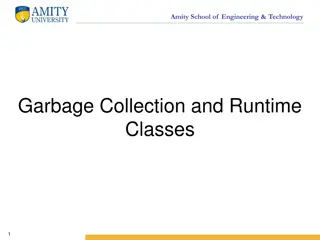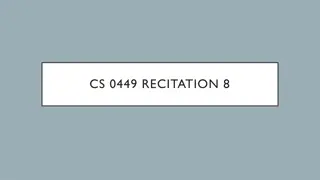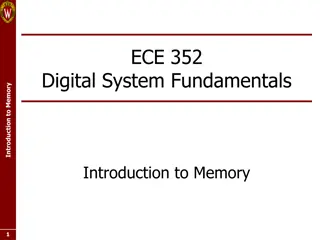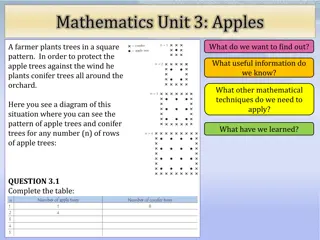
iOS App Development: Memory Management, Error Handling, and Protocols
Explore the key concepts of iOS app development including memory management with Automatic Reference Counting (ARC), error handling using do-catch structures, and protocols for declaring methods and properties. Learn about closures, strong and weak references, and implementing protocols in Swift.
Download Presentation

Please find below an Image/Link to download the presentation.
The content on the website is provided AS IS for your information and personal use only. It may not be sold, licensed, or shared on other websites without obtaining consent from the author. If you encounter any issues during the download, it is possible that the publisher has removed the file from their server.
You are allowed to download the files provided on this website for personal or commercial use, subject to the condition that they are used lawfully. All files are the property of their respective owners.
The content on the website is provided AS IS for your information and personal use only. It may not be sold, licensed, or shared on other websites without obtaining consent from the author.
E N D
Presentation Transcript
1 Native Mobile Applications - ICD0017 TalTech IT College, Andres K ver, 2018-2019, Spring semester Web: http://enos.Itcollege.ee/~akaver/MobileApps Skype: akaver Email: akaver@itcollege.ee
iOS Memory management 2 No Garbage Collection in SWIFT/iOS nothing gets thrown away automatically Instead, there is Automatic Reference Counting (ARC) Reference types (objects) are stored in the heap System automatically counts references to them When reference count goes to zero heap object is destroyed ARC can be modified weak strong unowned
iOS memory management 3 Strong default reference counting. As long as there is a pointer to this object, it s kept in head Weak keep this pointer alive, as long as somebody else has strong pointer to this object. If nobody is strongly interested anymore, set this pointer to nil. Outlets are typically weak view hierarchy has strong pointers to them Unowned don t do anything, crash if this points to nonexistent object when accessed. Used to break memory cycles
iOS closures and capturing 4 Closures can reference surrounding variables (capture them) Closures themselves are reference types (kept in heap) This can cause unbreakable memory cycles SendClosureSomewhere() { [ weak weakSelf = self ] in weakSelf?.someTextOutlet.textColor = UIColor.green }
iOS Error handling 5 Methods can throw errors (Exceptions) Such methods have throws at the end func saveToDb() throws You must use do catch structure for calling such function do { try saveToDb() } catch let error { // handle the error // rethrow (if code is in throws ) throw error }
iOS Error handling 6 Do it with force try! saveToDb() program crashes in case of error Or conditional let result = try? saveToDbGetChangeCountInt() // int?
iOS - Protocols 7 Similar to Interfaces in other languages Protocol is collection of method and property declarations Types can be declared as protocols (protocol is a type) Any class, struct or enum can implement unlimited number of protocols Normally any implementation of protocol must implement all methods/properties in protocol It is possible to declare some methods as optional in protocol Protocol has to be marked as @objc Implementer must inherit from NSObject
iOS - Protocols 8 protocol SomeProtocol : InheritedProtocol1, InheritedProtocol2 { var someProperty: Int { get set } func aMethod(arg1: Double, anotherArgument: String) -> SomeType mutating func changeIt() init(arg: Type) } Declaring Implementing class SomeClass : SuperclassOfSomeClass, SomeProtocol, AnotherProtocol { // implementation of SomeClass here // which must include everything in SomeProtocol & AnotherProtocol }
iOS Protocols, advanced 9 Protocols can restrict generics struct Range<Bound: Comparable> { let lowerBound: Bound let upperBound: Bound } Protocol itself can use generics protocol SomeProtocol { var someProperty: T { get set } associatedtype T }
iOS - Delegation 10 Implements blind communication between view and controller will should did CONTROLLER data at count MODEL VIEW
iOS - Delegation 11 View defines a protocol View has a weak delegate property of this protocol View uses delegate property to get/do things it needs Controller declares and implements the protocol Controller sets the delegate property in view to itself (view.delegate = self)
iOS - UI in code 12 Few pointers to get started Design first layout in storyboard Look at all the properties and constraints Drag a new controller, and copy over minimum amount of base UI Rest in code To remove UI element from view hierarchy (don t forget about Automatic Reference Counting are there any pointers to it somewhere around?) // remove view from stackview but it is still in view hierarchy columnStackView.removeArrangedSubview(viewToRemove) // remove view totally, will be destroyed by ARC viewToRemove.removeFromSuperview()
iOS - UI in code 13 @IBOutletweakvar gameBoard: UIStackView! var buttonCounter = 0 @IBActionfunc RowPlus(_ sender: UIButton) { // is everything empty if gameBoard.arrangedSubviews.count == 0 { print("Empty game board, adding initial empty stack into board") let columnStack = UIStackView() columnStack.axis = .vertical columnStack.alignment = .fill columnStack.distribution = .fillEqually columnStack.spacing = 8.0 gameBoard.addArrangedSubview(columnStack) } for subView in gameBoard.arrangedSubviews { iflet columnStack = subView as? UIStackView { let button = UIButton() button.backgroundColor = // this will show as colored square in xcode source code colorLiteral(red: 1, green: 0.8323456645, blue: 0.4732058644, alpha: 1) button.setTitle("\(buttonCounter)", for: UIControl.State.normal) buttonCounter += 1 columnStack.addArrangedSubview(button) } else { print("Found something else than UIStackView! WTF - What a Terrible Failure!") } } }
iOS - UI in code 14 @IBActionfunc RowMinus(_ sender: UIButton) { for subView in gameBoard.arrangedSubviews { iflet columnStack = subView as? UIStackView { // this only removes view from stack, but it is still in view hierarchy iflet viewToRemove = columnStack.arrangedSubviews.last { columnStack.removeArrangedSubview(viewToRemove) // remove view totally, will be destroyed viewToRemove.removeFromSuperview() } } else { print("Found something else than UIStackView! WTF?") } } iflet firstView = gameBoard.arrangedSubviews.first { iflet firstStackView = firstView as? UIStackView { let rowCount = firstStackView.arrangedSubviews.count if rowCount == 0 { for subView in gameBoard.arrangedSubviews { print("Removing empty stack from gameBoard") gameBoard.removeArrangedSubview(subView) subView.removeFromSuperview() } } } } }
iOS 15 The End!






















